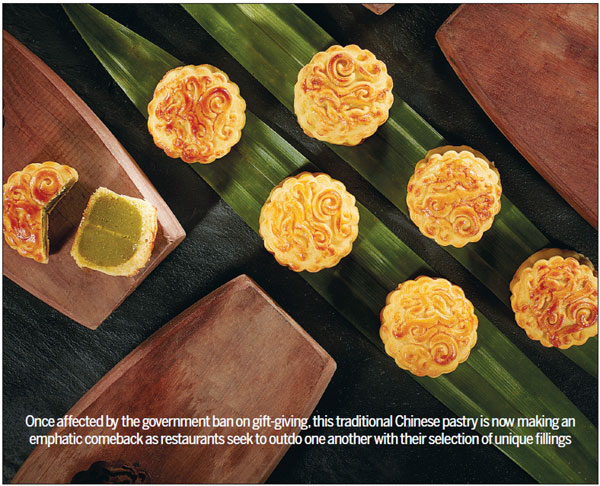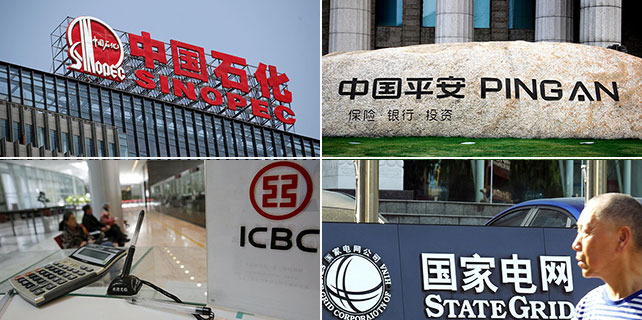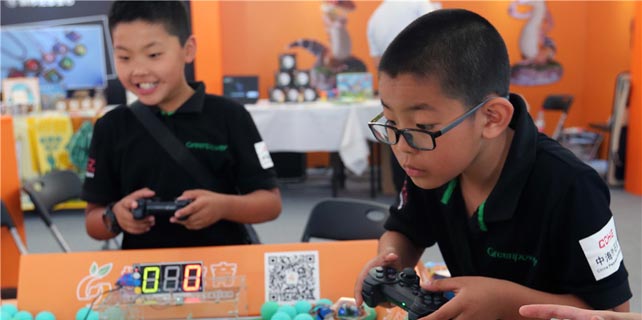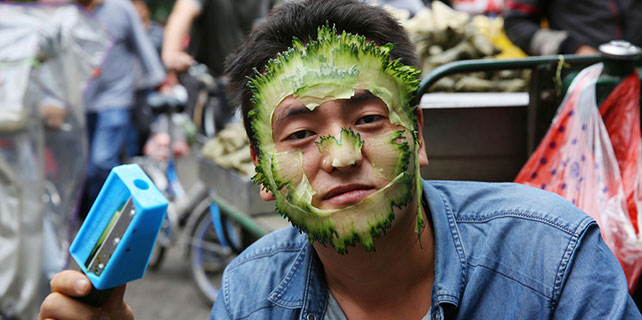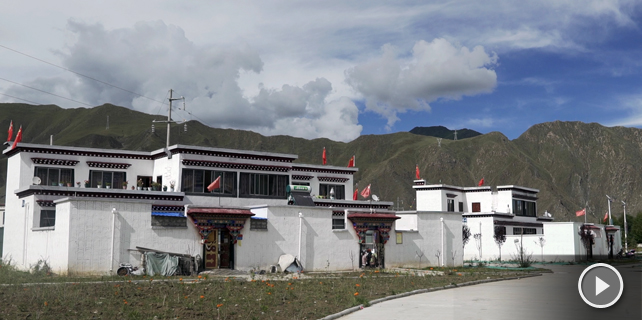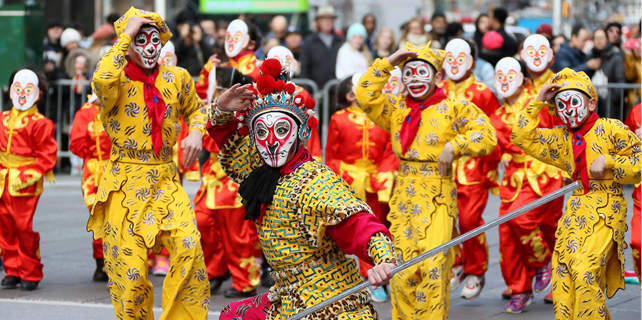The wax and wane of mooncakes
|
An overview of the mooncake production process.Photos By Gao Erqiang / China Daily |
Once affected by the government ban on gift-giving, this traditional Chinese pastry is now making an emphatic comeback as restaurants seek to outdo one another with their selection of unique fillings
The Xucheng Hotel in Suzhou may look like the typical, nondescript Chinese State-owned four-star hotel, but its fame among the locals certainly supercedes its uninspiring facade and interiors.
Widely considered to be one of the best mooncake makers in the city, the hotel's main restaurant - it does not even have a name - is helmed by chef Pan Xiaomin who showed no lack of candour when asked about his kitchen's rise to fame which started in the late 1990s.
"We started making mooncakes for the most absurd and irrelevant reason," laughed the 66-year-old, a no-nonsense man who is always armed with a cigar in one hand.
"The owner wanted to upgrade the hotel into a four-star property and this meant that our restaurant needed to introduce a Western pastry menu as stipulated by the national tourism authority."
Pan was livid at the demands, particularly because he knew it was impossible to teach his cooks how to make bread and cakes in such a short time.
Besides, his expertise was in crafting delicate Chinese dishes such as the famed sweet and sour squirrel fish and stir-fried river shrimps.
Almost nonchalantly, Pan settled on mooncakes, the traditional food that is consumed during the annual Mid-Autumn Festival, which falls on Oct 4 this year, simply because he knew how to make it.
There are many varieties of mooncakes on the market. The type that Pan produces is known as the Su-style version which comes with a flaky exterior similar to a croissant and is filled with savory fillings like pork. Since the mooncake was the only "Western-like pastry" the hotel restaurant had to offer, it was made available all year round.
The mooncakes by Xucheng Hotel have since become the accidental star in the local dining scene. In fact, they have even been recommended by China's most renowned food critic Shen Hongfei.
Sales of the mooncakes, which cost less than $1 per piece, have been growing steadily at an annual rate of more than 10 percent. This year, the hotel and its other branches in the city are expected to sell a record high of 3 million mooncakes.
One of the most important traditional Chinese festivals, the Mid-Autumn Festival is widely celebrated across the country and is seen as an occasion to reunite with family members. Mooncakes were invented to symbolize reunion and the pleasant memories brought by kinship.
Sun Chunli, deputy director of Xing Hua Lou Food and Restaurant, one of Shanghai's most historical mooncake makers that was established in 1851, noted that mooncakes were not commonplace before the 1950s because of limited production capacity and inaccessibility of ingredients like sugar and nuts.
Mooncakes during those times were also significantly larger, nearly the size of an adult person's palm. Then, a family would share just one piece of mooncake following dinner on the day of the Mid-Autumn Festival.
It was only after the 1990s when China reopened to the world that mooncakes started to become gifts.
|
The Shanghai Confectionery Industry Association says that consumers will be able to fi nd as many as 200 types of mooncakes on the market this year.Provided To China Daily |
A major switch in trends
According to Chen Feng-wei, secretary-general of the Shanghai Confectionery Industry Association, mooncakes used to be an important source of income for many bakeries and confectionery factories because they were a highly popular gift during the Mid-Autumn Festival.
In fact, the focus was hardly on the pastry itself, but on the elaborate packaging and the side gifts that could be as extravagant as gold bars.
In late 2013, the Communist Party of China banned government officials from using public funds for official gift-giving. The sales of mooncakes, together with other popular gifts like imported wines and luxury products, were severely hit since.
Because of the ban, mooncake makers were forced to innovate and rethink their business strategy. Instead of positioning the product as an attractive gift, bakeries introduced a larger selection of flavors and kept the prices affordable to the masses. What resulted was a sales boom.
"The anti-corruption ban has pushed every bakery and mooncake maker to stay competitive by replacing the traditionally dense pastries with novel ingredients," said Chen.
According to the Shanghai Confectionery Industry Association, there are as many as 200 types of mooncakes available on the market this year, up from 150 types last year. Newly invented fillings include cheese and crayfish, pickles and bullfrogs, and even fried rice.
The association also expects Shanghai residents to consume 22,000 tons of mooncakes this year, up by 15 percent from 2016.
Chen forecast that the sales of mooncakes this year is likely to rebound to a record high since the ban on gifting was introduced in 2013.
She added that the timing of this year's festival has also played a part.
"The festival this year is later than usual and this has extended the mooncake season by about two months, giving consumers an unusually long duration to savor the cakes," said Chen.
Making a killing
Shangri-La Hotel Group reported an average 10 percent increase in its mooncake sales from several of its properties, thanks to its newly created fillings like dried tea leaves and fresh spicy pork.
In 2015, Hong Kong enterprise Maxim's Group started to sell its famous salted egg yolk mooncakes on the Chinese mainland through its e-commerce store on Tmall. According to the company's management team, the decision to do this was made after they found that their mooncakes - they were bestsellers in Hong Kong for 19 consecutive years, according to Nielsen - were so popular among mainland consumers that other companies were copying their product.
The company expects the sales of the egg yolk mooncake on Tmall to grow three-fold from last year.
At Michelin-starred restaurant Yi Long Court at Peninsula Hotel Shanghai, the egg custard mooncakes have been widely credited as "the Hermes of mooncakes" because of the price tag - they cost around $10 each - and their exquisite quality. The mooncakes were said to be invented 30 years ago by chef Yip Wing-wah at the luxury hotel group's Hong Kong property.
"The mooncake scene is so competitive now that we have to keep introducing new offerings," said Tang Chi-keun, chef of Yi Long Court.
The restaurant introduced their handmade durian mooncakes last year and will follow up on that this year with a new pandan mooncake.
Tang added that the fillings for the durian mooncake are made with fresh durians imported from Penang in Malaysia.
"Competition inspires and motivates real chefs to be creative. Mooncakes, as well as other Chinese traditional desserts and pastries, can be as appealing as Western cakes. I think it's high time to spice them up," said Tang.
xujunqian@chinadaily.com.cn





